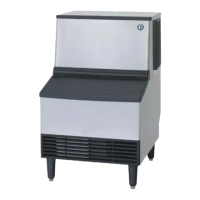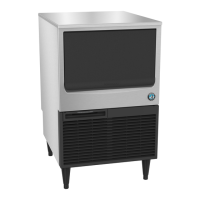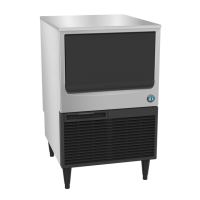17
B. Service Diagnosis
WARNING
• The appliance should be diagnosed and repaired only by quali¿ ed service
personnel to reduce the risk of death, electric shock, serious injury, or ¿ re.
• Risk of electric shock. Control switch in "OFF" position does not de-energize all
loads. Use extereme caution and exercise safe electrical practices.
• Moving parts (e.g., fan blade) can crush and cut. Keep hands clear.
• Before servicing the appliance, move the control switch to the “OFF“ position
and
unplug the appliance.
• CHOKING HAZARD: Ensure all components, fasteners, and thumbscrews are
securely in place after the appliance is serviced. Make sure that none have fallen
into the ice storage bin.
• Make sure all food zones in the appliance and ice storage bin are clean after
service.
The diagnostic procedure is basically a sequence check which can be used at unit
start-up or for system diagnosis. Using this check out procedure will allow you to
diagnose electrical system and component failures in approximately 10 minutes
under normal operating conditions of 70°F (21°C) or warmer air and 50°F (10°C)
or warmer water temperatures. Before conducting a 10 minute checkout, check for
correct installation, proper voltage per unit nameplate and adequate water supply.
As you go through the procedure, check to assure the components energize and
de-energize correctly. If not, those components and controls are suspect.
1) Remove the air ¿ lter. Move the control switch to the “OFF“ position, then unplug the
appliance. Access the control box. Clear any ice from the bin control actuator located
in the bin.
2) Plug in the appliance, then place the control switch in the “ICE” position. A 5 second
delay occurs. The “POWER OK” LED on the control board comes on. If the “POWER
OK” LED is À ashing (indicating a full bin), check the bin control. See “II. D. 1 Bin
Control Check”.
3) One Minute Fill Cycle – The inlet water valve is energized. After 1 minute, the control
board checks the À oat switch. If the À oat switch is closed, the unit cycles to harvest. If
closed, continue to step 4. If the À oat switch is open, the unit repeats the 1 minute ¿ ll
cycle until water enters and the À oat switch closes (low water safety protection during
initial start up and at the end of each harvest).
Diagnosis:
If the water valve does
not open, check for no supply voltage at water valve terminals, bad coil, or plugged
screen or external ¿ lter (no water À ow). If unit fails to start harvest, check for open
À oat switch or bad 1 minute timer in board.

